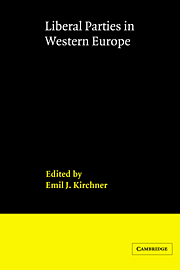Book contents
- Frontmatter
- Contents
- List of tables
- List of diagrams
- List of maps
- Notes on the contributors
- Preface
- 1 Introduction
- 2 Between left and right: the ambivalence of European liberalism
- 3 Two roads of Italian liberalism: the Partito Repubblicano Italiano (PRI) and the Partito Liberale Italiano (PLI)
- 4 The FDP in the Federal Republic of Germany: the requirements of survival and success
- 5 Great Britain — social liberalism reborn?
- 6 Liberalism in France
- 7 Liberal parties in the Netherlands
- 8 The Belgian liberal parties: economic radicals and social conservatives
- 9 The Freiheitliche Partei Österreichs: protest party or governing party?
- 10 The Swedish Liberal Party: The politics of unholy alliances
- 11 Liberalism in Denmark: agrarian, radical and still influential
- 12 The Norwegian Liberal Party: from political pioneer to political footnote
- 13 Liberal parties in Finland: from perennial coalition actors to an extra-parliamentary role
- 14 Liberal parties in Switzerland
- 15 The Luxemburg Liberal Party
- 16 Identifying liberal parties
- 17 Ambivalence revisited: an analysis of liberal party manifestos since 1945
- 18 Transnational links: the ELD and Liberal Party Group in the European Parliament
- 19 Western European liberal parties: developments since 1945 and prospects for the future
- Index of political parties
- General index
13 - Liberal parties in Finland: from perennial coalition actors to an extra-parliamentary role
Published online by Cambridge University Press: 16 November 2009
- Frontmatter
- Contents
- List of tables
- List of diagrams
- List of maps
- Notes on the contributors
- Preface
- 1 Introduction
- 2 Between left and right: the ambivalence of European liberalism
- 3 Two roads of Italian liberalism: the Partito Repubblicano Italiano (PRI) and the Partito Liberale Italiano (PLI)
- 4 The FDP in the Federal Republic of Germany: the requirements of survival and success
- 5 Great Britain — social liberalism reborn?
- 6 Liberalism in France
- 7 Liberal parties in the Netherlands
- 8 The Belgian liberal parties: economic radicals and social conservatives
- 9 The Freiheitliche Partei Österreichs: protest party or governing party?
- 10 The Swedish Liberal Party: The politics of unholy alliances
- 11 Liberalism in Denmark: agrarian, radical and still influential
- 12 The Norwegian Liberal Party: from political pioneer to political footnote
- 13 Liberal parties in Finland: from perennial coalition actors to an extra-parliamentary role
- 14 Liberal parties in Switzerland
- 15 The Luxemburg Liberal Party
- 16 Identifying liberal parties
- 17 Ambivalence revisited: an analysis of liberal party manifestos since 1945
- 18 Transnational links: the ELD and Liberal Party Group in the European Parliament
- 19 Western European liberal parties: developments since 1945 and prospects for the future
- Index of political parties
- General index
Summary
introduction
At the general election in March 1983, the Finnish Liberal People's Party, Liberaalinen Kansanpuolue (LKP), lost its toehold in the 200 seat national assembly (Eduskunta). This meant for the first time since the creation of a modern legislative system in Finland in 1907, there were no liberal representatives in parliament – precisely the same fate which had befallen the Norwegian Liberals (Venstre) two years earlier. To many observers of the Finnish political scene, this disastrous result for LKP came as little surprise, and the newspaper obituaries to mark the peaceful demise of the party were doubtless composed shortly after the Liberals' decision to become a member organisation of the Centre (formerly Agrarian) Party early in 1982. It was in this twilight world as ‘a party within a party’ that LKP lost all four of its parliamentarians and plummeted to an all-time nadir of 0.8 per cent of the active electorate in 1983. It seemed the end of the line for Finnish liberalism and its absorption into a federated political centre similar to the UDF in France.
The road back for the party will be long and hard. At the local government elections in October 1984, to be sure, LKP contrived to increase its vote slightly (1.3 per cent of the valid poll) and then emboldened by the resurgence of liberalism in neighbouring Sweden and the 14.3 per cent gained by Folkpartiet at the autumn 1985 general election, LKP seized the opportunity of breaking the knot with the Centre Party.
- Type
- Chapter
- Information
- Liberal Parties in Western Europe , pp. 326 - 358Publisher: Cambridge University PressPrint publication year: 1988



